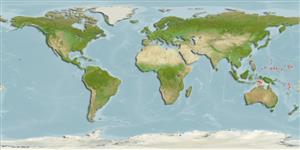Klassifizierung / Names
Namen | Synonyme | Catalog of Fishes(Gattung, Arten) | ITIS | CoL | WoRMS | Cloffa
>
Kurtiformes (Nurseryfishes, cardinalfishes.) >
Apogonidae (Cardinalfishes) > Apogoninae
Etymology: luteus: From the Latin for yellow in reference to its yellow coloration in life (Ref. 33415).
More on authors: Randall & Kulbicki.
Environment: milieu / climate zone / Tiefenbereich / distribution range
Ökologie
seewasser riff-verbunden; tiefenbereich 1 - 49 m (Ref. 37816). Tropical
Western Central Pacific: Philippines to the Marshall Islands.
Size / Gewicht / Alter
Geschlechtsreife: Lm ? range ? - ? cm
Max length : 4.4 cm SL Männchen/unbestimmt; (Ref. 33415)
Rückenflossenstacheln (insgesamt) : 8; Rückenflossenweichstrahlen (insgesamt) : 9; Afterflossenstacheln: 2; Afterflossenweichstrahlen: 8; Wirbelzahl: 24. Predorsal scales 4; preopercular edge serrate; preopercular ridge smooth to slightly crenulate; body depth 2.9-3.3 in SL; yellow with six narrow blue stripes on head, the two upper stripes usually continue faintly as broader purplish stripes on body; a blue-edged yellow stripe basally in second dorsal and anal fins; dorsal profile of head slightly convex (Ref. 33415).
Body shape (shape guide): fusiform / normal.
Inhabits sheltered clearwater areas of lagoon and seaward reefs. Aggregates under ledges, in holes, or even among spines of sea urchins. Feeds on planktonic crustaceans and small invertebrates by day and night (Ref. 37816).
Life cycle and mating behavior
Geschlechtsreife | Fortpflanzung | Ablaichen | Eier | Fecundity | Larven
A mouth-brooder. Distinct pairing during courtship and spawning (Ref. 205).
Myers, R.F., 1999. Micronesian reef fishes: a comprehensive guide to the coral reef fishes of Micronesia, 3rd revised and expanded edition. Coral Graphics, Barrigada, Guam. 330 p. (Ref. 37816)
IUCN Rote Liste Status (Ref. 130435: Version 2025-1)
Bedrohung für Menschen
Harmless
Nutzung durch Menschen
Tools
Zusatzinformationen
Download XML
Internet Quellen
Estimates based on models
Preferred temperature (Ref.
123201): 28.1 - 29.1, mean 28.5 °C (based on 20 cells).
Phylogenetic diversity index (Ref.
82804): PD
50 = 0.5000 [Uniqueness, from 0.5 = low to 2.0 = high].
Bayesian length-weight: a=0.01096 (0.00509 - 0.02362), b=3.09 (2.91 - 3.27), in cm total length, based on LWR estimates for this (Sub)family-body shape (Ref.
93245).
Trophic level (Ref.
69278): 3.5 ±0.49 se; based on food items.
Widerstandsfähigkeit (Ref.
120179): hoch, Verdopplung der Population dauert weniger als 15 Monate. (Preliminary K or Fecundity.).
Fishing Vulnerability (Ref.
59153): Low vulnerability (10 of 100).
🛈
Nutrients (Ref.
124155): Calcium = 272 [137, 741] mg/100g; Iron = 1.65 [0.79, 3.08] mg/100g; Protein = 18.8 [17.4, 20.1] %; Omega3 = 0.186 [0.078, 0.461] g/100g; Selenium = 42.6 [14.8, 108.9] μg/100g; VitaminA = 78.6 [19.7, 309.0] μg/100g; Zinc = 3.41 [1.94, 5.41] mg/100g (wet weight);
